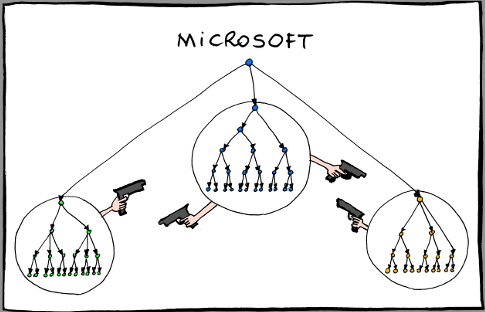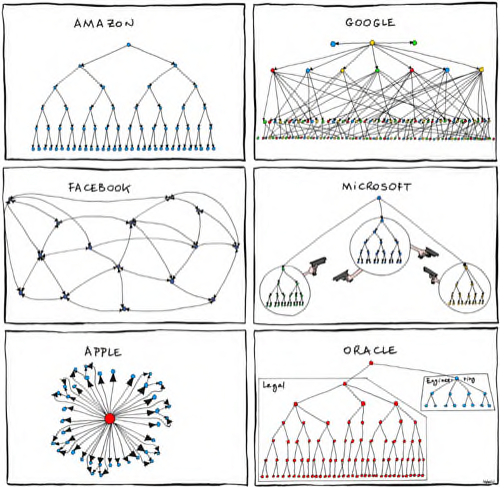
After a decade of missing lots of key growth opportunities and finding itself outpaced by competitors taking away market share, Microsoft’s board should have felt compelled to investigate much earlier why the company has fallen behind and demanded structural adjustments.
Bill Gates is the chairman of Microsoft’s board, a title he retained after he left the company in 2008.Today most pundits refer to him as a philanthropist, and rarely mention his Microsoft duties. Does this mean he is no longer focused on the company he founded? Outsiders and insiders alike have suspected and suggested this for some time. Only he can truly answer this question.
My speculation stems from the way the company is led by Bill’s friend and handpicked successor, CEO Steve Ballmer. Bill not only gave him the reins of the juggernaut, but also carte blanche to shape, operate, and direct it. Over the years, Steve has built a senior leadership team composed primarily of long-term Microsoft veterans who, under his tutelage, have been fixated on protecting the declining Windows and Office franchises, mostly through incremental product improvements.
While revenue and profits haven’t been severely hampered following this strategy, the company as a whole has become bloated and bureaucratic. The excitement of the earlier years is gone, and the company has settled, with a few exceptions, for protecting the status quo — despite having sufficient financial strength and talent to break out of this mold.
How Microsoft’s Structure Boxes It In
Since I published my book Resolve and Fortitude, in which I share my experiences and observations from working for nearly 20 years at Microsoft, I have talked and corresponded with many former, as well as current, Microsoft employees. A common thread emerges in these discussions: Steve Ballmer has architected an unusual and complex corporate structure and surrounded himself with yes-men and –women. The board probably considers him indispensable.
Looking mostly inward, he has mastered the company’s complexity — but seems to have difficulties, as demonstrated over the last decade, anticipating, responding to and fostering change and innovations in the marketplace. Even Bill Gates acknowledged the missed opportunities and the lack of innovating in a recent CBS interview. Is this a sign of forthcoming concrete actions or just a casual remark?
Evidence of Steve’s influence on the corporate structure is everywhere. His trusted COO, Kevin Turner, runs more than 50% of the total organization, including the field sales and marketing groups — a most awkward situation, considering his resume. Unlike his counterparts at other companies (or Bob Herbold, one of his predecessors), Turner has no control over the finances and the HR activities of the company.
When Steve Sinofsky departed as head of the Windows group, Microsoft split it in two. Today, one person is responsible for marketing and finance and another for development. This is a strange arrangement, considering the company already has a chief financial officer — and, furthermore, that product marketing in all other development teams always rests with the product group leader.
Management In The Maze
I could continue to analyze this further, but instead, let me look at the company from a different angle and discuss the management style being practiced.

Another common theme that comes up in my discussions is that Steve likes to meddle in all aspects of the company, seemingly micromanaging the various business units. People working for the senior leaders therefore feel that this disempowers them. They also suffer from decisions frequently made by committee, which both hinders response time and leads to a lack of accountability. To make things worse, the highly profitable Windows and Office franchises are blocking innovation and a healthy sense of paranoia. This is very comparable to the situation IBM found itself in during the early 1990s with regard to its mainframe business.
With the board and the CEO being weak when it comes to technical leadership, the onus is on the senior leaders to provide technical foresight. Being veterans and living to some degree in the past and having to please a controlling CEO makes this hard. From what I understand, the different departments continue to have turf battles, and sometimes give the impression of being fiefdoms, making it nearly impossible to execute a unified strategy. To me, it feels increasingly that Microsoft is tied up in an exceedingly complex knot, with infighting, factions, and bureaucratic inertia creating a stranglehold on the company.
The Alexandrian Solution
Alexander the Great was confronted with an equally intricate challenge when he invaded the Persian Empire in 333 B.C. We all know what he did to disentangle the so-called Gordian knot; he unsheathed his sword, splitting it in half. Later some people labeled his action the equivalent of cheating. I call this a sign of a bold leader because he thought outside the box. (Recall that he went on, as the legend predicted, to fulfill his destiny by conquering Persia!)
It is along these lines that I find the medicine that should enable Microsoft to regain new strength and conquer the IT universe once again. But not as a single company! It needs to be split in several parts to unlock value for stockholders and set its talent free from bondage. The feds tried this once before. Now Microsoft’s board should do it voluntarily by creating six independent companies:
- Operating systems for server, desktop and mobile devices
- Tools and languages for all platforms
- Productivity and business applications for all platforms
- Game consoles and game software for all gaming platforms
- Consulting for all platforms
- Internet related business (incl. browser, advertising, search, e-mail services, social media) for all platforms
Except for the first unit, all others would need to start expanding their business horizon by developing software and/or services for all relevant operating system platforms and not exclusively for Windows. The group developing the Azure platform is already on the way following this recipe by supporting Phone Gap, Apache’s Hadoop and the Android environment.
Unit six should be modeled along the lines of Google, and develop its own sexy browser, etc. The current IE browser integrated into Windows should be nothing more than a download vehicle for any available browser and could therefore be reduced in functionality.
Maybe this proposal is radical. But how else can you re-infuse entrepreneurial spirit in a company with a feeble or handcuffed leadership team, which mainly protects its own turf and ignores broader opportunities? To propel Microsoft out of its current predicament, I see no other way than to split the company into more manageable pieces.
If this means four or six independent companies at the end, well, that’s open for discussion. The key to success is to make the newly created enterprises hungry for new opportunities, and competitive enough to please shareholders and Wall Street alike.
A byproduct of such a move would be lower costs and less administrative fat because most of these separate units could no longer rely on Windows and Office subsidies. Also, the currently centralized research group would need to be split up accordingly and please its new masters by ensuring that research is not just done for the benefit of mankind, but for Microsoft’s shareholders.
Last but not least, this move — if ever accomplished — would shake up the leadership team and do away with the established fiefdoms. Let only the fittest and best survive!
Organization-chart cartoon courtesy of Manu Cornet. Lead image cropped from the full cartoon










